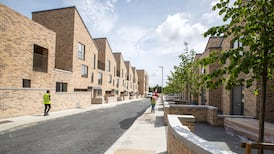Additional security measures have been put in place at a medieval site in Ballyfermot, Co Dublin, after footage showing someone interfering with skeletal remains was shared on social media.
The construction site is in the grounds of the former De La Salle monastery and primary school in Ballyfermot.
A video showing the alleged interference surfaced on X last Thursday with local People Before Profit councillor Hazel de Nortúin describing it as “extremely concerning”.
She was joined by Dublin City Council, the National Museum of Ireland and the National Monuments Service in condemning the alleged incident, which is being investigated by gardaí.
READ MORE
Up to 16 skeletal remains are understood to have been discovered at the site, where planning permission has been granted for the construction of 839 housing units, according to Cllr de Nortúin.
The council’s archaeology section is to inspect the site on Monday, and it is believed the site is “undamaged”.
Construction company Dwyer Nolan Developments are involved in the substantial build, which began in April 2023 on the 20-acre site, which is a mixed development of apartments and duplexes.
An archaeological excavation of a large double enclosure of early medieval date – from as far back as 600 AD – is under way under a Section 26 licence issued by the National Monuments Service.
A spokesperson for the National Museum explained that as part of archaeological testing in advance of the construction of a strategic housing development, “a number of early medieval burials were identified”.
“These are in a low burial mound, within a shallow-ditched enclosure. The majority are aligned west to east. To date, two burials have been identified with a north-south orientation.
“The different orientation of the two burials suggests the location could be associated with Hiberno-Norse settlement in the area. However, until the excavation and all analysis has been completed, it is not possible to conclusively state that.”
As excavations are ongoing it is “not possible to surmise if, or how many, more burials” will be identified, the spokesperson added.
The term Hiberno-Norse is used by archaeologists to describe the culture of inhabitants of Viking towns in the 11th and early 12th centuries. By the end of the 10th century the Vikings in Ireland had adopted Christianity, and with the fusion of cultures it is often difficult to distinguish between Viking and Irish artefacts at this time, according to the National Museum.
Gardaí are working with Dublin City Council and other relevant organisations, saying they are aware of the footage of “alleged interference with ancient human remains on the site”.
The council said that given the footage shows “human remains we would ask people to refrain from sharing it on social media. We are liaising with the archaeologists on site and An Garda Síochána”.
- Sign up for push alerts and have the best news, analysis and comment delivered directly to your phone
- Join The Irish Times on WhatsApp and stay up to date
- Listen to our Inside Politics podcast for the best political chat and analysis







